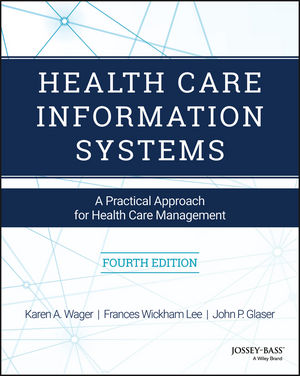Test Bank for Health Care Information Systems, 4th Edition, Karen A. Wager, Frances W. Lee, John P. Glaser

Product details:
- ISBN-10 : 1119337186
- ISBN-13 : 978-1119337188
- Author: Wager, Karen A., Lee, Frances W., Glaser, John P.
Health Care Information Systems is the newest version of the acclaimed text that offers the fundamental knowledge and tools needed to manage information and information resources effectively within a wide variety of health care organizations.
It reviews the major environmental forces that shape the national health information landscape and offers guidance on the implementation, evaluation, and management of health care information systems. It also reviews relevant laws, regulations, and standards and explores the most pressing issues pertinent to senior level managers.
Table contents:
- Chapter 1 Introduction to Computers in Health Information Management
- History of Computers in Healthcare
- Early Information Systems
- Modern Information Systems
- Impact of Computers on Healthcare
- Impact of Technology on Patient Care
- Patient Safety
- Evidence-Based Medicine
- Introduction to Health Informatics
- Introduction to Data Analytics
- Impact on the HIM Profession
- Chapter 2 Information Integrity and Data Quality
- Data Sources
- Primary Data Sources
- Secondary Data Sources
- Screen Design
- Data Capture
- Direct Data Entry
- Unstructured Data Fields
- Structured Data Fields
- Drop-Down Menus
- Check Box
- Radio Buttons
- Numeric Field
- Date Field
- Time Field
- Autonumbering
- Template-Based Data Entry
- Speech Recognition
- Natural Language Processing
- Data Integrity vs. Data Quality
- Data Dictionary
- Metadata
- Required Fields
- Edit Check
- Data Quality Management
- Data Accessibility
- Data Accuracy
- Data Comprehensiveness
- Data Consistency
- Data Currency
- Data Definition
- Data Granularity
- Data Precision
- Data Relevancy
- Data Timeliness
- Data Integrity Issues
- Data Collection
- Data Cleansing
- Data Mapping
- Version Control
- Security
- Organizational Culture of the Healthcare Organization
- Documentation Integrity Errors
- Patient Identification
- Authorship
- Dictation Errors
- Copying and Pasting
- Amendments to the Health Record
- Data Quality Measure
- Policies and Procedures
- Ensuring Data Integrity During the Sharing of Data
- Chapter 3 Introduction to Databases and Data Analytics
- Introduction to Databases and Data Analytics
- Requirements for Establishing a Database
- Database Management System
- Natural Language Queries
- Query by Example
- Structured Query Language
- Data Dictionary
- Vocabulary Standards
- Systematized Nomenclature of Medicine
- Data Modeling
- Data-Modeling Tools
- Common Database Models
- Relational Database Model
- Key Field
- Hierarchical Database Model
- Network Database Model
- Object-Oriented Database Model
- Multidimensional Database Model
- Data Repository and Data Warehouse
- Data Repository
- Data Warehouse
- Data Mart
- Data Mining
- Online Analytical Processing
- Common Uses and Examples in Healthcare and Health Information Management
- Chapter 4 System Selection
- Project Planning
- Planning
- Conducting a Feasibility Study
- Setting the Budget
- Goals and Objectives
- Identifying the Project Manager and Project Team
- Obtaining Buy-in from Management and Users
- Organization of the Project
- Project Team
- Defining Scope of Project
- Project Plan
- Project Management Tools
- Systems Analysis
- System Design
- Determining Who Will Build and Maintain the Information System
- Choosing Between Integrated and Interfaced Information Systems
- Integrated Information Systems
- Interfaced Information Systems
- System Selection
- Request for Information and Request for Proposal
- Letter of Introduction
- Information for Potential Vendors
- Description of the Proposed Information System
- Other RFP Requirements
- Evaluation of Proposed Information Systems
- Onsite Demonstrations
- Site Visits
- Reviewing RFP Responses
- Reference Checks
- Selection of an Information System
- Contract Negotiation
- Chapter 5 System Implementation
- System Implementation
- Site Preparation
- User Preparation
- Installing Hardware and Software
- Programming and Customization
- User Configurations and Settings
- User Interface Design
- Reengineering Processes
- Policy and Procedure Development and Documentation
- Testing Plan
- Types of Testing
- Test Plan
- Testing Documentation
- Training
- Planning for Training
- Contents of the Plan
- Selecting the Training Location
- Scheduling the Training
- Resources Needed
- Train the Trainer
- Conducting the Training
- Evaluating the Training
- Additional and Ongoing Training
- Computer-Assisted Instruction
- Documenting the Training
- Conversion
- Go-Live
- Go-Live Models
- Phased Approach
- Pilot Method
- Big Bang Method
- Straight (Direct) Turnover
- Parallel Processing
- Planning for Go-Live
- Initial Support
- Ongoing Support
- System Evaluation and Maintenance
- Chapter 6 Computerization in Health Informaticsand Information Management
- Traditional HIM Information Systems Job Titles and Descriptions
- Contemporary HIM Information Systems Job Titles
- Roles for the HIM Professional in the Healthcare Arena
- Health Information Management Systems Functions
- Disclosure of Health Information Systems
- Disclosure of Health Information System Functionality
- Disclosure of Health Information Reporting
- Encoder and Grouper
- Encoder and Grouper System Functionality
- Encoder and Grouper System Reporting
- Cancer and Other Registries
- Cancer (Tumor) Registry
- Cancer Registry Functionality
- Cancer Registry Reporting
- Trauma Registry
- Trauma Registry Functionality
- Trauma Registry Reporting
- Chart Locator System
- Chart Locator Functionality
- Chart Locator Reporting
- Chart Deficiency System
- Chart Deficiency Functionality
- Chart Deficiency System Reporting
- Birth Certificate System
- Birth Certificate System Functionality
- Birth Certificate System Reporting
- Dictation and Transcription Systems
- Dictation System Functionality and Reporting
- Transcription System Functionality and Reporting
- Healthcare Quality Indicator System
- Healthcare Quality Indicator System Functionality
- Healthcare Quality Indicator System Reporting
- Computer-Assisted Coding System
- CAC System Functionality
- CAC System Reporting
- Clinical Documentation Improvement System
- CDI Software Functionality
- CDI Information System Reporting
- Chapter 7 Administrative Information Systems
- Financial Information System
- Financial Information System Functionality
- Impact on HIM
- Human Resources Information System
- Human Resource Information System Functionality
- Impact on HIM
- Decision Support System
- Executive Information System
- Master Patient Index
- Master Patient Index Functionality
- Enterprise Master Patient Index
- Impact on HIM
- Patient Registration (Registration—Admission, Discharge, Transfer)
- Functionality
- Impact on HIM
- Scheduling System
- Functionality
- Impact on HIM
- Practice Management
- Functionality
- Impact on HIM
- Materials Management System
- Functionality
- Impact on HIM
- Facilities Management
- Functionality
- Impact on HIM
- Chapter 8 Clinical Information Systems
- Clinical Decision Support
- Document Management System
- Document Management System Versus Electronic Health Record
- Components of a Document Management System
- Scanner
- Scanning Workstation
- Printers
- Annotation
- Advantages and Disadvantages
- Space Savings
- Retrieval of Large Number of Records
- Productivity Gains
- Online Availability of Information
- System Security and Control
- Database Retrieval
- Lack of Manipulation or Reporting
- Fear of Change
- Implementation
- Justification of Cost
- Forms
- Staffing Changes
- Process Redesign
- When to Scan the Health Record
- Immediately Following Discharge
- Scanning Upon Completion
- Retrieval of Images
- Future of Document Management System
- Radiology Information System
- Laboratory Information System
- Nursing Information System
- Pharmacy Information System
- Interdisciplinary Charting System
- Emergency Department System
- Anesthesia Information System
- Patient Monitoring System
- Telehealth
- Smart Card
- Impact of Clinical Information Systems on HIM
- Chapter 9 Electronic Health Record
- Purpose and Components of the Electronic Health Record
- Status of EHR Adoption
- Certified EHR Technology
- Components of EHR
- Registration—Admission, Discharge, Transfer
- Patient Financial Services
- Order Communication and Results Retrieval
- Ancillary, Clinical, and Department Applications
- Patient Monitoring Systems
- Document Management System
- Clinical Messaging and Provider-Patient Portals
- Results Management
- Point-of-Care Charting
- Computerized Physician or Provider Order Entry System
- Electronic Medication Administration Record
- Clinical Decision Support System
- Health Information Exchange
- Population Health
- Benefits of the EHR
- Barriers to EHR Use
- Signatures
- Copy and Paste Concerns
- EHR Tools
- Data Retrieval
- Graphical User Interface
- Color and Icons
- Data Entry
- Unstructured Data
- Structured Data
- Template-Based Entry
- Natural Language Processing
- Legal Issues
- Unanticipated Issues in EHR Use
- Transition Period—Hybrid Record
- Impact on Health Information Management
- Chapter 10 Consumer Informatics
- Health Literacy
- Consumer Health Applications
- Telehealth
- Consumer Informatics Applications
- Patient Portals
- Personal Health Record
- Social Media
- Chapter 11 Health Information Exchange
- Interoperability and Health Information Exchange
- History of Health Information Exchange
- Benefits and Barriers to Health Information Exchange
- Meaningful Use
- Models of Health Information Exchange Architecture
- Consolidated or Centralized Model
- Federated or Decentralized Model
- Hybrid Model
- Methods of Health Information Exchange
- Directed Exchange
- Query-Based Exchange
- Consumer-Mediated Exchange
- Patient Identification
- Health Information Exchange Privacy Concerns
- Chapter 12 Security
- Introduction to Health Information Portability and Accountability Act of 1996
- Transaction and Code Sets Rule
- Privacy Rule
- Security Rule
- American Recovery and Reinvestment Act of 2009
- Security Threats and Safeguards
- Administrative Safeguards and the Security Management Process
- Risk Analysis
- Risk Management
- Sanction Policy
- Information System Activity Review
- Assigned Security Responsibility
- Workforce Security
- Managing a Security Incident
- Ongoing Security Procedure Evaluation
- Contingency and Business Continuity Planning
- Data Recovery
- Business Associate Contracts or Other Arrangements
- Technical Safeguards
- Access Control Systems and Authentication
- Types of Authentication
- User Authentication Methods
- Audit Controls
- Integrity
- Malicious Software
- Virus
- Worms
- Trojans
- Bots
- Spyware
- Ransomware
- Social Engineering
- Baiting
- Phishing
- Email Hacking and Contacts
- Pretexting
- Quid pro quo
- Vishing
- Physical Safeguards
- Facility Access Controls
- Workstation Use and Security
- Device and Media Controls
- Mobile Security
- Fire and Natural Disasters
- Penalties
- Certifications
- Certified in Healthcare Privacy and Security
- Certified Information Systems Security Professional
- Certified Information Security Manager
- Chapter 13 Security Compliance and Monitoring
- Importance of Compliance
- Covered Entity Compliance Plan
- Introduction to Auditing and Monitoring
- Internal vs. External Audits
- Written Policies, Procedures, and Standards of Conduct
- Chief Security Official (Compliance Officer)
- Training and Education
- Effective Communication
- Enforcement
- Prompt response to noncompliance
- Standards
- Benchmarking
- Department of Health and Human Services
- Results of the OCR Audit Program
- Resolution Agreement
- Audit Program
- Selection
- Planning
- Metrics
- Fieldwork
- Audit
- Data Collection
- Data Analysis
- Documentation of Compliance Activities
- Corrective Action Plan
- Reporting
- Follow-up
- Training
- Compliance Monitoring and Information Systems
- Computer Forensics
- Databases
- Dashboard
- Appendix A RFI/RFP Template
- Appendix B Check Your Understanding Answer Key
- Glossary
- Index
People also search:
health care information systems 4th edition pdf
health care information systems 4th edition
information systems used in healthcare
what are the health information systems
information systems in healthcare chamberlain quiz 1





